Pitched Battles 2021
Contents  2 The Vice 2 The Vice | ||
Books
| Book | Kind | Edition | Last update | |
 General’s Handbook ’2021 General’s Handbook ’2021 | ||||
 General’s Handbook ’2021 General’s Handbook ’2021 | Expansion | 3 | September 2021 | |
PITCHED BATTLES 2021 BATTLEPACK
Getting Started
We’ve provided a step-by-step guide to help you prepare for the first few Pitched Battles you play. These steps outline the essential details you’ll need to get a Pitched Battle up and running in no time!- First, you need to do is agree on the points limit for the battle.
- Next, pick 1 faction for your army and consult the Pitched Battles table to see the restrictions that apply when picking your units.
- Then, record the details of your army on your army roster. This includes the grand strategy you have selected, the units you have included and the enhancements you have picked for them (see Fill Out Your Army Roster).
- Finally, determine the battleplan you will play (see To War!), making sure that you have read the Ghurish Heartlands realm rules before the battle begins. All that remains is to fight the battle itself!
Pitched Battles
Battles fought using this battlepack are Pitched Battles. The following rules apply to battles fought using this battlepack:1. Points Limit
You and your opponent will first need to agree on a points limit for the battle. The points limit for the battle can be either 1000 or 2000. After you have agreed on a points limit, look it up on the Pitched Battles table below. The table lists the restrictions on what the players can include in their armies.
| |||||||||||||||||||||||||||||||||
2. Pick Your Army
Next, you must pick your army following the restrictions below.| See Pitched Battle Publications 2021 for a list of publications whose rules you are allowed to use when picking your army. | ||
Faction
You must pick 1 faction for your army. All of the units in your army must be from a single faction.Battlefield Roles
The Pitched Battles table lists the minimum number of Leader and Battleline units you must include in your army and the maximum number of Leader, Behemoth and Artillery units you can include in your army.Your general must have the Leader battlefield role. A model that has both the Leader and Behemoth battlefield roles counts as 1 Leader and 1 Behemoth in your army. If a unit has both the Battleline and Behemoth battlefield roles, that unit does not count toward the maximum number of Behemoth units you can include in your army.
| Remember that allied units are ignored when determining if the units in the army are from a single faction (core rules, 27.1). | ||
Battalions
You can include core battalions in your army but you cannot include warscroll battalions.Understrength and Reinforced Units
The Pitched Battles table lists how many reinforced units you can include in your army. Only Battleline units can be reinforced twice. You cannot include understrength units in a Pitched Battle army.Allied Units
The maximum number of points that you can spend on allies from your points allowance is shown on the Pitched Battles table. Allied units do not count towards the number of Battleline units in your army. However, they do count towards the maximum number of Leader, Behemoth and Artillery units in your army.Coalition Units
Coalition units do not count towards the number of Battleline units in your army. However, they do count towards the maximum number of Leader, Behemoth and Artillery units in your army. In addition, Coalition units are ignored when determining if the units in your army are from a single faction.| Like allied units, coalition units are units from another faction that can be included in your army without preventing you from using your army’s allegiance abilities. Coalition units differ from allies in that they are more closely tied to your army’s faction. Thus, restrictions that apply to allies do not necessarily apply to coalition units; for instance, coalition units can be given enhancements. Examples of units that can be included in an army as ccalition units are Chaos Warriors with the Mark of Khorne in a Blades of Khorne army and Stormcast Eternals units in a Cities of Sigmar army. If an army can include coalition units, this will be explained in the allegiance abilities for the army’s faction. | ||
Endless Spells and Invocations
The Pitched Battles table lists the maximum number of endless spells and invocations you can include in your army. You cannot include the same endless spell or invocation more than once in your army.3. Fill Out Your Army Roster
Once you have picked your army, record the details on your army roster and show it to your opponent before setting up your army at the start of the battle. Your roster must include a list of the units, battalions, endless spells and invocations in your army; what size the units are; the army’s faction; the grand strategy you have picked; which units are allies; and which model is the army’s general.Use the Notes column on the roster to record the command models you have chosen for each unit, the spells and prayers that are known by the WIZARDS and PRIESTS in your army, any artefacts of power you have given to HEROES in your army, and the command trait you have chosen for your general. If your army includes any units that are given keywords when they are set up, such as units with a Mark of Chaos, these keywords must be written down when the unit is added to the roster.
Grand Strategies
When you are filling out your army roster, you can pick 1 grand strategy. Your grand strategy represents what your army is trying to accomplish, and achieving it can make all the difference in a closely fought battle. The rules for how to use grand strategies can be found here.4. To War!
After the players’ army rosters have been filled out, it’s time to determine the battleplan that you will use. In addition, this section detail special rules that apply to battles fought using this battlepack.Pitched Battle Battleplans
The players roll off and the winner rolls a dice. On a 1-3, Battleplan Table 1 is used; on a 4-6, Battleplan Table 2 is used (see below). Then, their opponent rolls a dice to determine which battleplan is used for the game.
| ||||||||||||||||||||||||||||||||||||||
Battle Tactics
Battle tactics are secondary objectives that the armies can attempt to achieve as the opportunity presents itself during the battle. Each battle tactic you pick will give you a new goal for your army to aim for in each of your turns. The rules for how to use battle tactics can be found here.Realm Rules
You must use the Ghurish Heartlands realm rules.Terrain Features
The Pitched Battles table lists the recommended minimum number of terrain features to be set up on the battlefield. Each terrain feature must be set up more than 3" from the battlefield edge, more than 6" from all other terrain features and more than 3" from all objectives. If it is impossible for a terrain feature to be set up, it is not used.| Some events will have battlefields with terrain features that have been set up before both players arrive at the table, or the position of terrain features may have been predetermined by a third party. If this is the case, the players roll off to determine who is the attacker and defender as normal, with the attacker picking the territory in which they wish to deploy and setting up the first unit. If a faction terrain feature must be set up before any other terrain features and the battlefield has already been set up by a third party, set up that faction terrain feature before territories are determined. | ||
Faction Terrain
Faction terrain features must be set up more than 3" from all other terrain features and more than 3" from all objectives. These restrictions are in addition to the set-up rules in the battletome in which they appear. If it is impossible for a faction terrain feature to be set up, it is not used.Mysterious Terrain
The defender must roll on the Mysterious Terrain table from the core rules (see 28.1.3) to determine additional scenery rules that apply to any terrain features that do not have a warscroll. Roll on the Mysterious Terrain table for each applicable terrain feature after it has been set up.Alternating Deployment
If a battleplan says that the players use alternating deployment, then the players alternate setting 1 unit at a time. The players continue to set up their units until both armies have been set up. If one player finishes setting up their army first, their opponent must set up the rest of the units in their army, one after another.Stealing the Initiative
Do not roll off to determine who has priority in the first battle round. Instead, the player who finished deploying their army first has priority in the first battle round.Battleplan Marking Territory 1 1Two warring tribes are locked in a battle for territory, both seeking complete dominance over the other. Who will yield first? THE ARMIES Each player picks an army and then they roll off. The winner chooses which player is the attacker and which is the defender.THE BATTLEFIELD The defender sets up the battlefield. First, they set up objectives as shown on the map. Then, they set up the recommended number of terrain features shown on the Pitched Battles table.DEPLOYMENT The attacker picks which territory is their territory. The other territory is the defender’s territory.The players then use alternating deployment, starting with the attacker. Each player must set up their units wholly within their territory. BATTLE LENGTH The battle lasts for 5 battle rounds.GLORIOUS VICTORY Starting from the third battle round, one player immediately wins a major victory if they control all of the objectives on the battlefield.If neither player has won a major victory by the end of the battle, then the player that completed the most battle tactics wins a minor victory. If both players completed the same number of battle tactics, then if only one player completed their grand strategy, that player wins a minor victory. If both players or neither player completed their grand strategy, the battle is a draw. 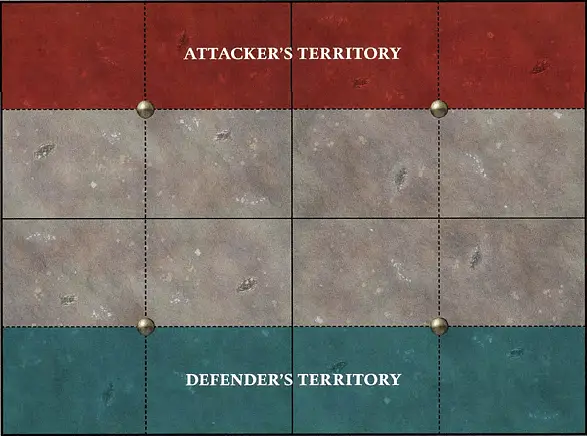 | ||
Battleplan Savage Gains 2 2These two forces can no longer suffer each other’s presence in this region. A final clash will decide who claims these lands as their own and who bends the knee. THE ARMIES Each player picks an army and then they roll off. The winner chooses which player is the attacker and which is the defender.THE BATTLEFIELD The defender sets up the battlefield. First, they set up objectives as shown on the map. Then, they set up the recommended number of terrain features shown on the Pitched Battles table.PRIME OBJECTIVES The objectives located on the border of each player’s territory are prime objectives. Unless noted otherwise, prime objectives cannot be removed from the battlefield.DEPLOYMENT The attacker picks which territory is their territory. The other territory is the defender’s territory. The players then use alternating deployment, starting with the attacker. Each player must set up their units wholly within their territory.VICTORY POINTS Each player scores victory points at the end of each of their turns as follows:- Score 1 victory point if you control the objective on the border of your territory. - Score 2 victory points for each objective you control that is not on the border of either player’s territories. - Score 4 victory points if you control the objective on the border of your opponent’s territory. - Score 2 victory points if you completed the battle tactic you picked that turn. GRAND STRATEGY Each player scores 3 victory points at the end of the battle if they completed their grand strategy.BATTLE LENGTH The battle lasts for 5 battle rounds.GLORIOUS VICTORY The player with the most victory points at the end of the battle wins a major victory.If the players are tied on victory points at the end of the battle, then the player that completed the most battle tactics wins a minor victory. If both players completed the same number of battle tactics, then if only one player completed their grand strategy, that player wins a minor victory. If both players or neither player completed their grand strategy, the battle is a draw. 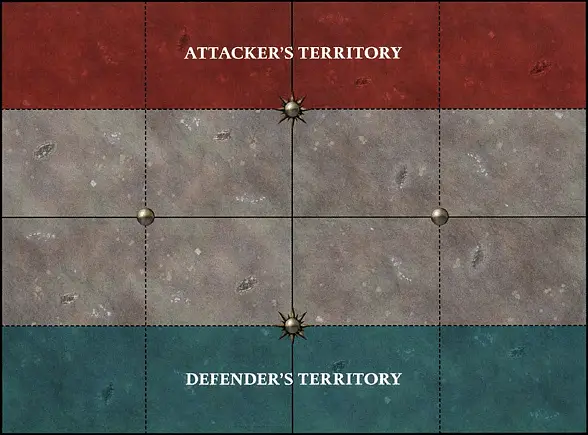 | ||
Battleplan First Blood 3 3Scouting has paid off for two forces vying to expand their domain. With the knowledge of what lies ahead, each side seeks to make an early show of dominance. THE ARMIES Each player picks an army and then they roll off. The winner chooses which player is the attacker and which is the defender.THE BATTLEFIELD The defender sets up the battlefield. First, they set up objectives as shown on the map. Then, they set up the recommended number of terrain features shown on the Pitched Battles table.DEPLOYMENT The attacker picks which territory is their territory. The other territory is the defender’s territory.The players then use alternating deployment, starting with the attacker. Each player must set up their units wholly within their territory. VANTAGE POINT At the start of each battle round, after the players have received their start-of-round command points, the player taking the second turn must pick 1 objective on the battlefield to be the vantage point. When a player receives their start-of-round command points, if they control the vantage point, they receive 1 extra command point.VICTORY POINTS Each player scores victory points at the end of each of their turns as follows:- Score 1 victory point if you control at least one objective. - Score 1 victory point if you control two or more objectives. - Score 1 victory point if you control more objectives than your opponent. - Score 2 victory points if you completed the battle tactic you picked that turn. GRAND STRATEGY Each player scores 3 victory points at the end of the battle if they completed their grand strategy.BATTLE LENGTH The battle lasts for 5 battle rounds.GLORIOUS VICTORY The player with the most victory points at the end of the battle wins a major victory.If the players are tied on victory points at the end of the battle, then the player that completed the most battle tactics wins a minor victory. If both players completed the same number of battle tactics, then if only one player completed their grand strategy, that player wins a minor victory. If both players or neither player completed their grand strategy, the battle is a draw. 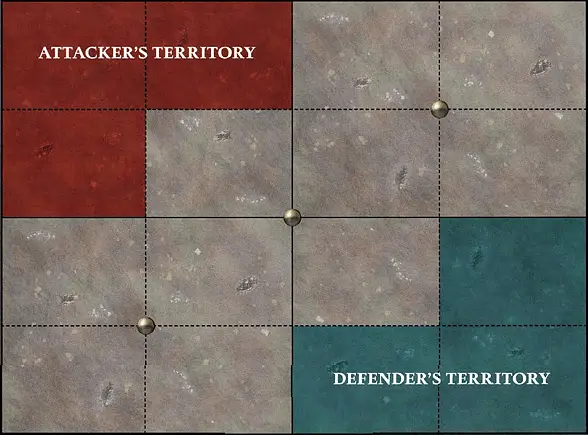 | ||
Battleplan Power Struggle 4 4Two stubborn warlords have created a stalemate at the borders of Thondia, both refusing to fall back to re-supply. Now they must commit everything they have to secure new ground. THE ARMIES Each player picks an army and then they roll off. The winner chooses which player is the attacker and which is the defender.THE BATTLEFIELD The defender sets up the battlefield. First, they set up objectives as shown on the map. Then, they set up the recommended number of terrain features shown on the Pitched Battles table.DEPLOYMENT The attacker picks which territory is their territory. The other territory is the defender’s territory.The players then use alternating deployment, starting with the attacker. Each player must set up their units wholly within their territory. HOLD YOUR GROUND In this battle, some victory points are only scored for objectives you control once you have controlled that objective for two of your turns consecutively. These turns can carry over into the next battle round.VICTORY POINTS Each player scores victory points at the end of each of their turns as follows:- Score 1 victory point if you have controlled at least one objective for two of your turns consecutively. - Score 1 victory point if you have controlled two or more objectives for two of your turns consecutively. - Score 1 victory point if you control more objectives than your opponent. - Score 2 victory points if you completed the battle tactic you picked that turn. GRAND STRATEGY Each player scores 3 victory points at the end of the battle if they completed their grand strategy.BATTLE LENGTH The battle lasts for 5 battle rounds.GLORIOUS VICTORY The player with the most victory points at the end of the battle wins a major victory.If the players are tied on victory points at the end of the battle, then the player that completed the most battle tactics wins a minor victory. If both players completed the same number of battle tactics, then if only one player completed their grand strategy, that player wins a minor victory. If both players or neither player completed their grand strategy, the battle is a draw. 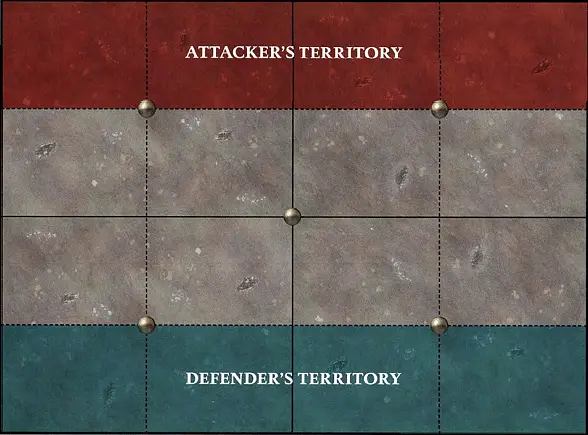 | ||
Battleplan Survival of the Fittest 5 5In Ghur, only the mightiest may rule and strength is proven at the edge of a blade. Commanders will unleash their greatest warriors against one another, trusting in the primal laws of combat to determine the victors. THE ARMIES Each player picks an army and then they roll off. The winner chooses which player is the attacker and which is the defender.THE BATTLEFIELD The defender sets up the battlefield. First, they set up objectives as shown on the map. Then, they set up the recommended number of terrain features shown on the Pitched Battles table.DEPLOYMENT The attacker picks which territory is their territory. The other territory is the defenders territory.The players then use alternating deployment, starting with the attacker. Each player must set up their units wholly within their territory and more than 9" from their opponent’s territory. TOP OF THE FOOD CHAIN After armies have been set up, before determining who has the first turn in the first battle round, each player must pick 3 different friendly units on the battlefield, starting with the attacker. These units are your predator units for the battle.VICTORY POINTS Each player scores victory points at the end of each of their turns as follows:- Score 1 victory point if you control at least one objective. - Score 1 victory point if you control two or more objectives. - Score 1 victory point if you control more objectives than your opponent. - Score 1 victory point for each enemy predator unit that was destroyed by a friendly predator unit during that turn. - Score 2 victory points if you completed the battle tactic you picked that turn. GRAND STRATEGY Each player scores 3 victory points at the end of the battle if they completed their grand strategy.BATTLE LENGTH The battle lasts for 5 battle rounds.GLORIOUS VICTORY The player with the most victory points at the end of the battle wins a major victory.If the players are tied on victory points at the end of the battle, then the player that completed the most battle tactics wins a minor victory. If both players completed the same number of battle tactics, then if only one player completed their grand strategy, that player wins a minor victory. If both players or neither player completed their grand strategy, the battle is a draw. 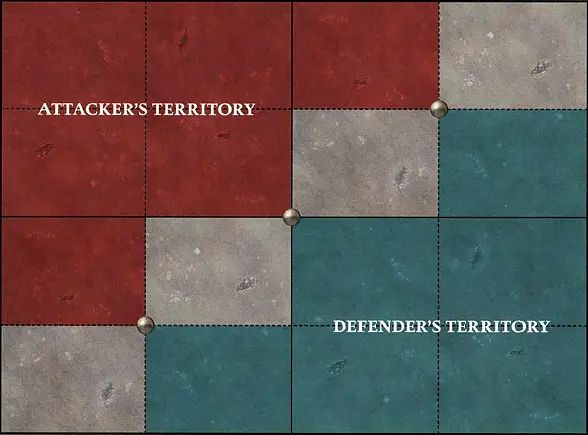 | ||
Battleplan Tectonic Interference 6 6From the Fraktom Crevasse to the Coast of Tusks, Thondia is rocked by powerful earthquakes. Two armies have met in the midst of such a series of tremors, seizing what ground they can before Ghur’s rage reduces it to ruin. THE ARMIES Each player picks an army and then they roll off. The winner chooses which player is the attacker and which is the defender.THE BATTLEFIELD The defender sets up the battlefield. First, they set up objectives as shown on the map. Then, they set up the recommended number of terrain features shown on the Pitched Battles table.PRIME OBJECTIVES The objectives in this battle are prime objectives. Unless noted otherwise, a prime objective cannot be removed from the battlefield.DEPLOYMENT The attacker picks which territory is their territory. The other territory is the defender’s territory.The players then use alternating deployment, starting with the attacker. Each player must set up their units wholly within their territory and more than 9" from their opponents territory. ALPHA AND BETA OBJECTIVES At the start of each battle round, before determining who has the first turn, roll a D3. The objective with the corresponding number is the alpha objective for that battle round, and the other 2 objectives are the beta objectives for that battle round.VICTORY POINTS Each player scores victory points at the end of each of their turns as follows:- Score 2 victory points if you control the alpha objective. - Score 1 victory point for each beta objective you control. - Score 2 victory points if you completed the battle tactic you picked that turn. GRAND STRATEGY Each player scores 3 victory points at the end of the battle if they completed their grand strategy.BATTLE LENGTH The battle lasts for 5 battle rounds.GLORIOUS VICTORY The player with the most victory points at the end of the battle wins a major victory.If the players are tied on victory points at the end of the battle, then the player that completed the most battle tactics wins a minor victory. If both players completed the same number of battle tactics, then if only one player completed their grand strategy, that player wins a minor victory. If both players or neither player completed their grand strategy, the battle is a draw. 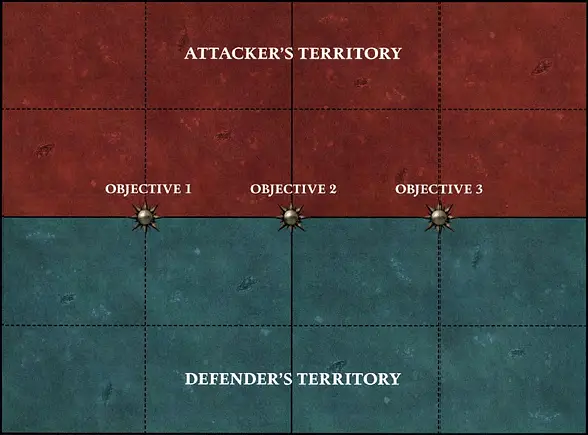 | ||
Battleplan Apex Predators 1 1Amidst the storm-wracked Thunderscorn Peaks, two armies have met at the sight of an ancient tribal tomb. Should a war leader prove themselves worthy, the spirits of Ghur will infuse them with new power. THE ARMIES Each player picks an army and then they roll off. The winner chooses which player is the attacker and which is the defender.THE BATTLEFIELD The defender sets up the battlefield. First, they set up objectives as shown on the map. Then, they set up the recommended number of terrain features shown on the Pitched Battles table.DEPLOYMENT The attacker picks which territory is their territory. The other territory is the defender’s territory.The players then use alternating deployment, starting with the attacker. Each player must set up their units wholly within their territory and more than 9" from their opponent’s territory. ALTARS OF THE BEAST The normal rules for objective marker control and contesting objectives are not used. The only ways to gain control of an objective are as follows:- A friendly Leader unit finishes a move other than a retreat move within 3" of the objective, and no enemy Leader unit is within 3" of the objective. - An attack made with a melee weapon by a friendly Leader unit within 3" of the objective destroys an enemy Leader unit within 3" of the objective. Once you gain control of an objective, it remains under your control until your opponent gains control of it or until there is no friendly Leader unit within 3" of it. VICTORY POINTS Each player scores victory points at the end of each of their turns as follows:- Score 1 victory point if you control at least one objective. - Score 1 victory point if you control two or more objectives. - Score 1 victory point if you control more objectives than your opponent. - Score 2 victory points if you completed the battle tactic you picked that turn. GRAND STRATEGY Each player scores 3 victory points at the end of the battle if they completed their grand strategy.BATTLE LENGTH The battle lasts for 5 battle rounds.GLORIOUS VICTORY The player with the most victory points at the end of the battle wins a major victory.If the players are tied on victory points at the end of the battle, then the player that completed the most battle tactics wins a minor victory. If both players completed the same number of battle tactics, then if only one player completed their grand strategy, that player wins a minor victory. If both players or neither player completed their grand strategy, the battle is a draw. 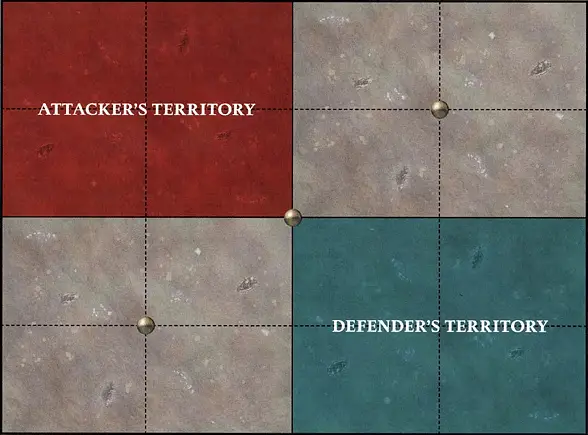 | ||
Battleplan The Vice 2 2Two forces have come to blows amidst the shadows of an ancient crevasse. As the battle unfolds, both generals discover that the chasm is gradually closing in around them. Victory here must be swift for any hope of escape. THE ARMIES Each player picks an army and then they roll off. The winner chooses which player is the attacker and which is the defender.THE BATTLEFIELD The defender sets up the battlefield. First, they set up objectives in each corner of the battlefield as shown on the map. Then, they set up the recommended number of terrain features shown on the Pitched Battles table.PRIME OBJECTIVES The objectives in this battle are prime objectives. Unless noted otherwise, prime objectives cannot be removed from the battlefield.DEPLOYMENT The attacker picks which territory is their territory. The other territory is the defender’s territory.The players then use alternating deployment, starting with the attacker. Each player must set up their units wholly within their territory and more than 12" from their opponent’s territory. THE VICE At the start of the second battle round, before determining who has the first turn, each objective is moved to a new location as shown on the map.At the start of the fourth battle round, before determining who has the first turn, remove all 4 objectives from the battlefield and place a new objective at the centre of the battlefield. VICTORY POINTS Each player scores victory points at the end of each of their turns as follows:- Score 1 victory point if you control at least one objective. - Score 1 victory point if you control two or more objectives. - Score 1 victory point if you control more objectives than your opponent. - Score 2 victory points if you completed the battle tactic you picked that turn. GRAND STRATEGY Each player scores 3 victory points at the end of the battle if they completed their grand strategy.BATTLE LENGTH The battle lasts for 5 battle rounds.GLORIOUS VICTORY The player with the most victory points at the end of the battle wins a major victory.If the players are tied on victory points at the end of the battle, then the player that completed the most battle tactics wins a minor victory. If both players completed the same number of battle tactics, then if only one player completed their grand strategy, that player wins a minor victory. If both players or neither player completed their grand strategy, the battle is a draw. 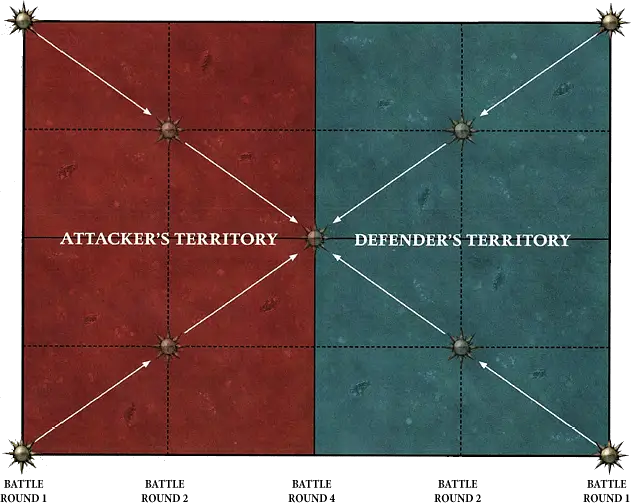 | ||
Battleplan Tooth and Nail 3 3In the Drowned Lands of Thondia, it can take days for reinforcements to navigate the bogs and marshes. Warriors must fight on even as fatigue sets in, while the mystical powers of the fens play havoc with any new arrivals. THE ARMIES Each player picks an army and then they roll off. The winner chooses which player is the attacker and which is the defender.THE BATTLEFIELD The defender sets up the battlefield. First, they set up objectives as shown on the map. Then, they set up the recommended number of terrain features shown on the Pitched Battles table.PRIME OBJECTIVES The objectives located wholly within each player’s territory are prime objectives. Unless noted otherwise, prime objectives cannot be removed from the battlefield.DEPLOYMENT The attacker picks which territory is their territory. The other territory is the defender’s territory.The players then use alternating deployment, starting with the attacker. Each player must set up their units wholly within their territory and more than 9" from their opponent’s territory. NO RESERVES All units must be set up on the battlefield before the battle begins. If a unit is set up in reserve, all of the models in the unit are slain and the unit is destroyed.FATIGUED WARRIORS Summoned units cannot shoot or charge in the turn in which they were added to your army.VICTORY POINTS Each player scores victory points at the end of each of their turns as follows:- Score 1 victory point if you control at least one objective. - Score 1 victory point if you control two or more objectives. - Score 1 victory point if you control more objectives than your opponent. - Score 2 victory points if you completed the battle tactic you picked that turn. GRAND STRATEGY Each player scores 3 victory points at the end of the battle if they completed their grand strategy.BATTLE LENGTH The battle lasts for 5 battle rounds.GLORIOUS VICTORY The player with the most victory points at the end of the battle wins a major victory.If the players are tied on victory points at the end of the battle, then the player that completed the most battle tactics wins a minor victory. If both players completed the same number of battle tactics, then if only one player completed their grand strategy, that player wins a minor victory. If both players or neither player completed their grand strategy, the battle is a draw. 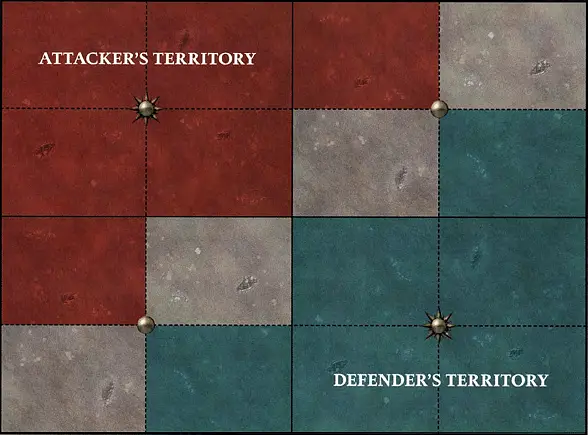 | ||
Battleplan Feral Foray 4 4The Great Excelsis Road is littered with the remains of convoys preyed upon by beasts of the wild. Often, supplies remain amidst the ruins, and so two armies have arrived, each seeking to carry off the abandoned loot before their enemy can do the same. THE ARMIES Each player picks an army and then they roll off. The winner chooses which player is the attacker and which is the defender.THE BATTLEFIELD The defender sets up the battlefield. First, they set up objectives as shown on the map. Then, they set up the recommended number of terrain features shown on the Pitched Battles table.DEPLOYMENT The attacker picks which territory is their territory. The other territory is the defender s territory.The players then use alternating deployment, starting with the attacker. Each player must set up their units wholly within their territory and more than 9" from their opponents territory. RAIDING OBJECTIVES From the start of the second battle round, after you score victory points, you can raid 1 objective that you control, that is wholly within your opponent’s territory and that is within 1" of a friendly unit. If you do so, you score 1 additional victory point. The objective is then removed from play. You cannot raid more than 1 objective per turn.VICTORY POINTS Each player scores victory points at the end of each of their turns as follows:- Score 1 victory point if you control at least one objective. - Score 1 victory point if you control two or more objectives. - Score 1 victory point if you control more objectives than your opponent. - Score 2 victory points if you completed the battle tactic you picked that turn. GRAND STRATEGY Each player scores 3 victory points at the end of the battle if they completed their grand strategy.BATTLE LENGTH The battle lasts for 5 battle rounds.GLORIOUS VICTORY The player with the most victory points at the end of the battle wins a major victory.If the players are tied on victory points at the end of the battle, then the player that completed the most battle tactics wins a minor victory. If both players completed the same number of battle tactics, then if only one player completed their grand strategy, that player wins a minor victory. If both players or neither player completed their grand strategy, the battle is a draw. 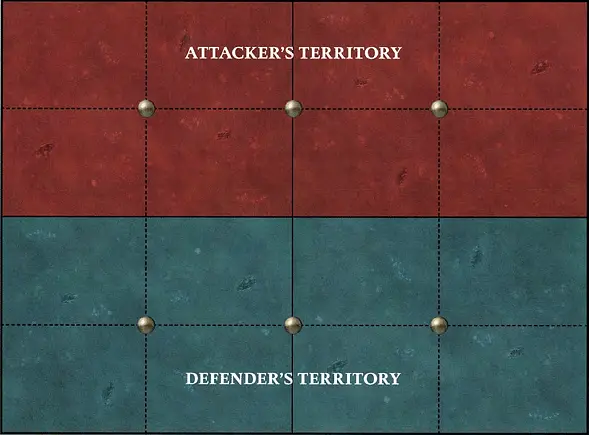 | ||
Battleplan Power in Numbers 5 5Two factions have been locked in a struggle amidst the valleys of the Krondspine Range for days. With no victory in sight, both generals opt to commit their forces to a final, brutal engagement. THE ARMIES Each player picks an army and then they roll off. The winner chooses which player is the attacker and which is the defender.THE BATTLEFIELD The defender sets up the battlefield. First, they set up objectives as shown on the map. Then, they set up the recommended number of terrain features shown on the Pitched Battles table.DEPLOYMENT The attacker picks which territory is their territory. The other territory is the defender’s territory.The players then use alternating deployment, starting with the attacker. Each player must set up their units wholly within their territory. THE BACKBONE OF SUCCESS If there are any Battleline units within 6" of an objective, then only models from Battleline units can contest that objective.VICTORY POINTS Each player scores victory points at the end of each of their turns as follows:- Score 2 victory points if you completed the battle tactic you picked that turn. Starting from the second battle round, at the end of each of their turns, a player can destroy 1 or more of the objectives they control in order to score the following victory points: - If the player gained control of the objective in this turn, they score 1 victory point. - If the player controlled the objective at the end of their last turn and has not lost control of it since, they score 2 victory points. - If the player controlled the objective at the end of their turn before last and has not lost control of it since, they score 4 victory points. - If the player gained control of the objective in the first battle round and has not lost control of it by the end of their turn in the fifth battle round, they score 8 victory points. If more than one of these criteria are met for the same objective, only the one that scores the most victory points applies. Once destroyed, an objective is removed from play. GRAND STRATEGY Each player scores 3 victory points at the end of the battle if they completed their grand strategy.BATTLE LENGTH The battle lasts for 5 battle rounds.GLORIOUS VICTORY The player with the most victory points at the end of the battle wins a major victory.If the players are tied on victory points at the end of the battle, then the player that completed the most battle tactics wins a minor victory. If both players completed the same number of battle tactics, then if only one player completed their grand strategy, that player wins a minor victory. If both players or neither player completed their grand strategy, the battle is a draw. 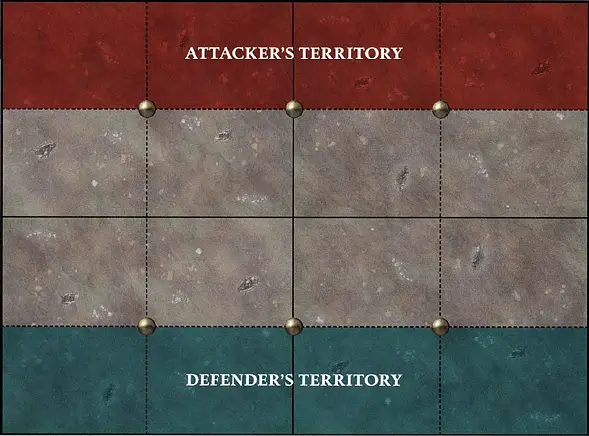 | ||
Battleplan The Veins of Ghur 6 6Ley lines of arcane power cross Thondia, many of which connect in some form to the lands around Excelsis. Two forces have met upon such a ley line to do battle, little realising that the deposits of amberstone here will reduce even the most aloof to raging beasts. THE ARMIES Each player picks an army and then they roll off. The winner chooses which player is the attacker and which is the defender.THE BATTLEFIELD The defender sets up the battlefield. They set up the recommended number of terrain features shown on the Pitched Battles table.DEPLOYMENT The attacker picks which territory is their territory. The other territory is the defender’s territory. The players then use alternating deployment, starting with the attacker. Each player must set up their units wholly within their territory.REALMSTONE VEINS 3 objectives are set up during the battle. The first objective is set up at the start of the second battle round, before determining who has the first turn. The second and third objectives are set up at the start of the third battle round, before determining who has the first turn.Each objective corresponds to a line on the battlefield (see map). When setting up each objective, roll 2D6 and set it up where its corresponding line crosses the line that corresponds to the roll. PRIME OBJECTIVES The objectives in this battle are prime objectives. Unless noted otherwise, prime objectives cannot be removed from the battlefield.VICTORY POINTS Each player scores victory points at the end of each of their turns as follows:- Score a number of victory points equal to the number of the current battle round for each objective you control. - Score 2 victory points if you completed the battle tactic you picked that turn. GRAND STRATEGY Each player scores 3 victory points at the end of the battle if they completed their grand strategy.BATTLE LENGTH The battle lasts for 5 battle rounds.GLORIOUS VICTORY The player with the most victory points at the end of the battle wins a major victory.If the players are tied on victory points at the end of the battle, then the player that completed the most battle tactics wins a minor victory. If both players completed the same number of battle tactics, then if only one player completed their grand strategy, that player wins a minor victory. If both players or neither player completed their grand strategy, the battle is a draw. 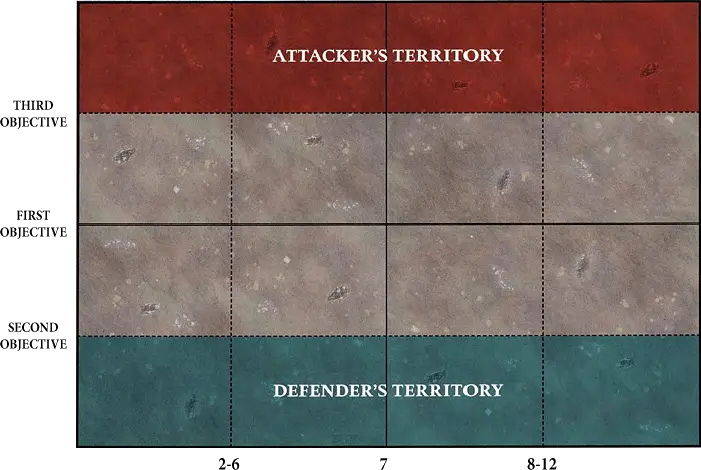 | ||
REALM RULES
Region of War: The Ghurish Heartlands
The following rules capture the carnivorous nature of Ghur and the effects this feral realm has upon its inhabitants and landscapes.Special Rules
Predators and Prey: Ghur is a land of monsters, where the laws of the hunt are paramount. Only armies possessed of the greatest strength and cunning can triumph here, whether by unleashing their own great warbeasts or by slaying those of their enemies.Once per battle round, you score 1 additional victory point if any enemy MONSTERS were slain in that battle round.
Seismic Shift: The continent ofThondia is no less feral than the creatures that call it home. Periodically, the ground rumbles and cracks with violent tremors, and what may have been a key strategic position is suddenly reduced to rubble.
At the start of the third battle round, after the players roll off to determine who has the first turn, the player taking the second turn in that battle round can pick 1 objective marker on the battlefield and remove it from play.
| Units with the MONSTER keyword will give your army some powerful advantages this tournament season. These units have the potential to earn you extra victory points in your games, and because of the Feral Roar realm command they will be even tougher to kill! What’s more, the Metamorphosis spell means that you can grant the MONSTER keyword to a HERO of your choice, meaning they can reap all of the other benefits that being a MONSTER brings, including going on a monstrous rampage (core rules, 21.1). Go on - heed the call of Ghur and give in to your primal instincts! | ||
Realmsphere Magic
All WIZARDS know the following spell in addition to any others that they know:Metamorphosis: The wizard channels the wild soul of Ghur to transform a chosen ally into a monstrous beast.
Metamorphosis is a spell that has a casting value of 5 and a range of 12". If successfully cast, pick 1 friendly HERO that is not a MONSTER and that is within range and visible to the caster. That HERO gains the MONSTER keyword until your next hero phase.
Realm Command
Each player can use the following command ability in addition to any others that they can use:Feral Roar: Channelling the spirit of Ghur, the commander looses a roar that sees monsters of all shapes and sizes fight on without heed of injury or pain.
You can use this command ability at the start of the combat phase. The unit that receives the command must be a MONSTER. Until the end of that phase, when you look up a value on that unit's damage table, it is treated as if it has suffered 0 wounds.
Core Battalions
You can include any of the following core battalions in your army in addition to those found in the core rules. In addition, you cannot include the same core battalion from those shown below more than once in your army.
|
|
Grand Strategies
After you have picked your army, you must pick 1 grand strategy from the list below and record it on your army roster. At the end of the battle, if you completed your grand strategy, you score additional victory points as described in the battleplan you are playing.Sever the Head: When the battle ends, you complete this grand strategy if there are no HEROES from your opponents starting army on the battlefield. Hold the Line: When the battle ends, you complete this grand strategy if there are any Battleline units from your starting army on the battlefield. Vendetta: When the battle ends, you complete this grand strategy if the model chosen to be your opponent’s general has been slain and the model chosen to be your general has not been slain. Dominating Presence: When the battle ends, you complete this grand strategy if there are more units from your starting army on the battlefield than there are units from your opponent’s starting army on the battlefield. Beast Master: When the battle ends, you complete this grand strategy if there are any MONSTERS from your starting army on the battlefield.Prized Sorcery: When the battle ends, you complete this grand strategy if there are any WIZARDS from your starting army on the battlefield. Pillars of Belief: When the battle ends, you complete this grand strategy if there are any PRIESTS from your starting army on the battlefield. Predator’s Domain: When the battle ends, you complete this grand strategy if you control more terrain features than your opponent. | ||
Battle Tactics
At the start of your hero phase, you must pick 1 battle tactic from the list below. You must reveal your choice to your opponent, and if your battle tactic instructs you to pick something, you must tell your opponent what you pick. You have until the end of that turn to complete the battle tactic. You cannot pick the same battle tactic more than once per battle.Broken Ranks: When you reveal this battle tactic, pick 1 Battleline unit from your opponent’s starting army on the battlefield. You complete this battle tactic if that unit is destroyed during this turn. If that unit was destroyed by an attack made by a friendly MONSTER or an ability of a friendly MONSTER, score 1 additional victory point. Conquer: When you reveal this battle tactic, pick 1 objective marker on the battlefield that your opponent controls. You complete this battle tactic if you control that objective marker at the end of this turn. Slay the Warlord: You complete this battle tactic if the model chosen to be your opponent’s general is slain during this turn. If that model was destroyed by an attack made by a friendly MONSTER or an ability of a friendly MONSTER, score 1 additional victory point. Ferocious Advance: When you reveal this battle tactic, pick 3 different units from your starting army on the battlefield. You complete this battle tactic if all of the units you picked run in the following movement phase and finish that run within 3" of each other. If all 3 of those units are MONSTERS, score 1 additional victory point. Bring It Down!: When you reveal this battle tactic, pick 1 enemy MONSTER on the battlefield. You complete this battle tactic if that unit is destroyed during this turn. If that enemy MONSTER was destroyed by an attack made by a friendly MONSTER or an ability of a friendly MONSTER, score 1 additional victory point. Aggressive Expansion: When you reveal this battle tactic, pick 2 objective markers on the battlefield that are not wholly within your territory. You complete this battle tactic if you control both objective markers at the end of this turn. Monstrous Takeover: When you reveal this battle tactic, pick 1 MONSTER from your starting army on the battlefield. You complete this battle tactic if that MONSTER is contesting an objective marker that you control at the end of this turn, and that objective marker is not contested by an enemy MONSTER. Savage Spearhead: You complete this battle tactic if there are 2 or more units from your starting army wholly within your opponent’s territory at the end of this turn. If 2 or more of those units are MONSTERS, score 1 additional victory point. | ||
Scoring Sheet
At the conclusion of a Pitched Battle, the player who has scored the most victory points is declared the winner. Victory points can be achieved in a variety of different ways, so it is vital to be able to track the methods by which victory points are attained and the number of victory points scored by a player. We have provided a scoring sheet template, opposite, so that you can effectively track the progress of your battles.
On the scoring sheet (download link), there’s a space at the top to record the points limit of the battle and the battleplan being played. Beneath that are two coloured sections: one to record the information of the attacker and one to record the information of the defender.
After determining who will be the attacker and who will be the defender, write each player’s name at the top of the appropriate coloured section along with the grand strategy they picked.
There are spaces in both the attacker and the defender sections to note all of the battle tactics they pick during the battle and if they are completed. In addition, there are spaces to track the number of objectives that each player controls at the end of each of their turns, as well as the number of victory points they have scored.
At the end of the battle, both players can mark if they completed their grand strategy and add up the number of victory points they scored. Then, they can mark the result of the battle in the section at the bottom of the sheet.
After determining who will be the attacker and who will be the defender, write each player’s name at the top of the appropriate coloured section along with the grand strategy they picked.
There are spaces in both the attacker and the defender sections to note all of the battle tactics they pick during the battle and if they are completed. In addition, there are spaces to track the number of objectives that each player controls at the end of each of their turns, as well as the number of victory points they have scored.
At the end of the battle, both players can mark if they completed their grand strategy and add up the number of victory points they scored. Then, they can mark the result of the battle in the section at the bottom of the sheet.
Pitched Battle Publications 2021
As Warhammer Age of Sigmar continues to grow, naturally we will continue to write rules for the game. However, when you are playing competitively, sometimes it’s hard to know which of these rules are ‘legal’ - in other words, which rules you can use in Pitched Battles. Below we’ve provided a handy at-a-glance list which shows you all the publications whose rules you are allowed to use in Pitched Battles.Core
- Warhammer Age of Sigmar Core Book
- General’s Handbook: Pitched Battles 2021
- Pitched Battle Profiles 2021
Battletomes
- Battletome: Beasts of Chaos
- Battletome: Blades of Khorne
- Battletome: Cities of Sigmar
- Battletome: Daughters of Khaine
- Battletome: Disciples of Tzeentch
- Battletome: Flesh-eater Courts
- Battletome: Fyreslayers
- Battletome: Gloomspite Gitz
- Battletome: Hedonites of Slaanesh
- Battletome: Idoneth Deepkin
- Battletome: Kharadron Overlords
- Battletome: Lumineth Realm-lords
- Battletome: Maggotkin of Nurgle
- Battletome: Nighthaunt
- Battletome: Ogor Mawtribes
- Battletome: Orruk Warclans
- Battletome: Ossiarch Bonereapers
- Battletome: Seraphon
- Battletome: Skaven
- Battletome: Slaves to Darkness
- Battletome: Sons of Behemat
- Battletome: Soulblight Gravelords
- Battletome: Stormcast Eternals
- Battletome: Sylvaneth
Expansions
- Wrath of the Everchosen
- Broken Realms: Morathi
- Broken Realms: Teclis
- Broken Realms: Be’lakor
- Broken Realms: Kragnos
Other Publications
- Compendium: Monstrous Arcanum (excluding Warhammer Legends Pitched Battle profiles)
25.3.2 Reinforced Units
A reinforced unit has twice as many models as its minimum unit size. If you can include reinforced units in your army, you can reinforce units with the Battleline battlefield role twice. A unit that is reinforced twice has 3 times as many models as its minimum unit size and counts as 2 units towards the number of reinforced units you can include in your army. If the description for a unit says that it is a single model, it cannot be reinforced.
27.3.2 Command Traits
Each time you take a command trait enhancement, you can pick 1 command trait and give it to your general. You can never pick more than 1 command trait for your army, and command traits can only be given to a general that is a HERO.
1.4.2 Your General
After you have picked your army, you must pick 1 model in your army to be your general. Generals are used to generate command points (see 6.0).
1.5.3 Rolling Off
Sometimes a rule may require the players to roll off. To roll off, each player rolls a dice, and whoever rolls highest wins. If a roll-off is tied, roll off again. You cannot re-roll or modify the dice when you roll off.
Alternating Deployment
If a battleplan says that the players use alternating deployment, then the players alternate setting 1 unit at a time. The players continue to set up their units until both armies have been set up. If one player finishes setting up their army first, their opponent must set up the rest of the units in their army, one after another.
8.2 Retreat
When you pick a unit to retreat, you can move each model in that unit a distance in inches equal to or less than the Move characteristic shown on the unit’s warscroll. The unit must end the move more than 3" from all enemy units. You cannot shoot or attempt a charge later in the turn with a unit that has retreated. Units cannot retreat if they are not within 3" of an enemy unit.
3.1 Reserve Units and Summoned Units
Sometimes a rule will allow you to set up a unit in a location other than the battlefield as a reserve unit. A unit that is added to your army once the battle is underway is called a summoned unit.When you set up a reserve unit, either during deployment or once the battle is underway, you must tell your opponent that the unit is in reserve and keep it to one side instead of placing it on the battlefield. At the start of the fourth battle round, units that are still in reserve are destroyed. Units cannot cast spells or use abilities while they are in reserve unless the spell or ability specifically says it can be used by reserve units.
| Reserve units are picked as part of your army before the battle begins, while summoned units are units added to your army once the battle is underway. Models that have been removed from play can be used as part of a summoned unit. | ||
19.1 Casting Spells
In your hero phase, you can attempt to cast spells with friendly WIZARDS. You cannot attempt to cast the same spell more than once in the same hero phase, even with a different WIZARD. In order to attempt to cast a spell, pick a friendly WIZARD, say which of the spells that they know will be attempted, and then make a casting roll by rolling 2D6. If the casting roll is equal to or greater than the casting value of the spell, the spell is successfully cast.
6.1 Using Command Abilities
To use a command ability, you must spend 1 command point, pick 1 friendly model to issue the command, and pick 1 friendly unit to receive the command. Unless noted otherwise, the models that can issue commands and the units they can issue them to are as follows:- Unit champions can issue commands to their own unit (see 22.3.2).
- HEROES can issue commands to units that are wholly within 12" of them.
- Generals can issue commands to units that are wholly within 18" of them.
- TOTEMS can issue commands to units that are wholly within 18" of them.
8.1 Normal Move
When you pick a unit to make a normal move, you can move each model in that unit a distance in inches equal to or less than the Move characteristic shown on the unit’s warscroll. Units cannot move within 3" of enemy units when making a normal move. Units cannot make a normal move if they are within 3" of an enemy unit.
Starting Armies
Several grand strategies and battle tactics refer to a player’s starting army. A player’s starting army is made up of the units in the army that were set up before the first battle round, including any reserve units. Units that are added to a player’s army after the battle has begun are not included, and neither are units that have been destroyed and subsequently returned to play.
8.3 Run
When you pick a unit to run, you must make a run roll for the unit by rolling a dice. Add the run roll to the Move characteristic of all models in the unit until the end of that phase. You can then move each model in that unit a distance in inches equal to or less than their modified Move characteristic. No part of a run can be within 3" of an enemy unit. You cannot shoot or attempt a charge later in the turn with a unit that has run. Units cannot run if they are within 3" of an enemy unit.
Contents  2 The Vice 2 The Vice | ||